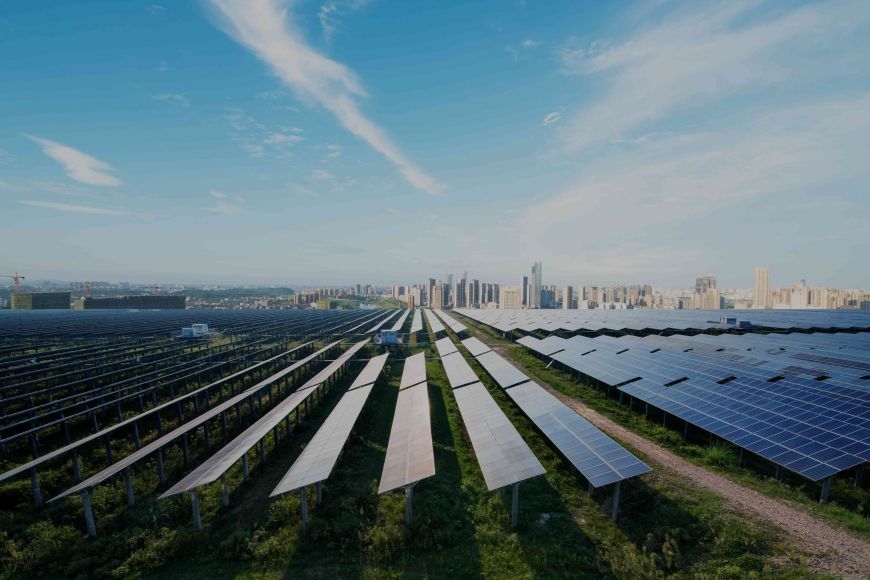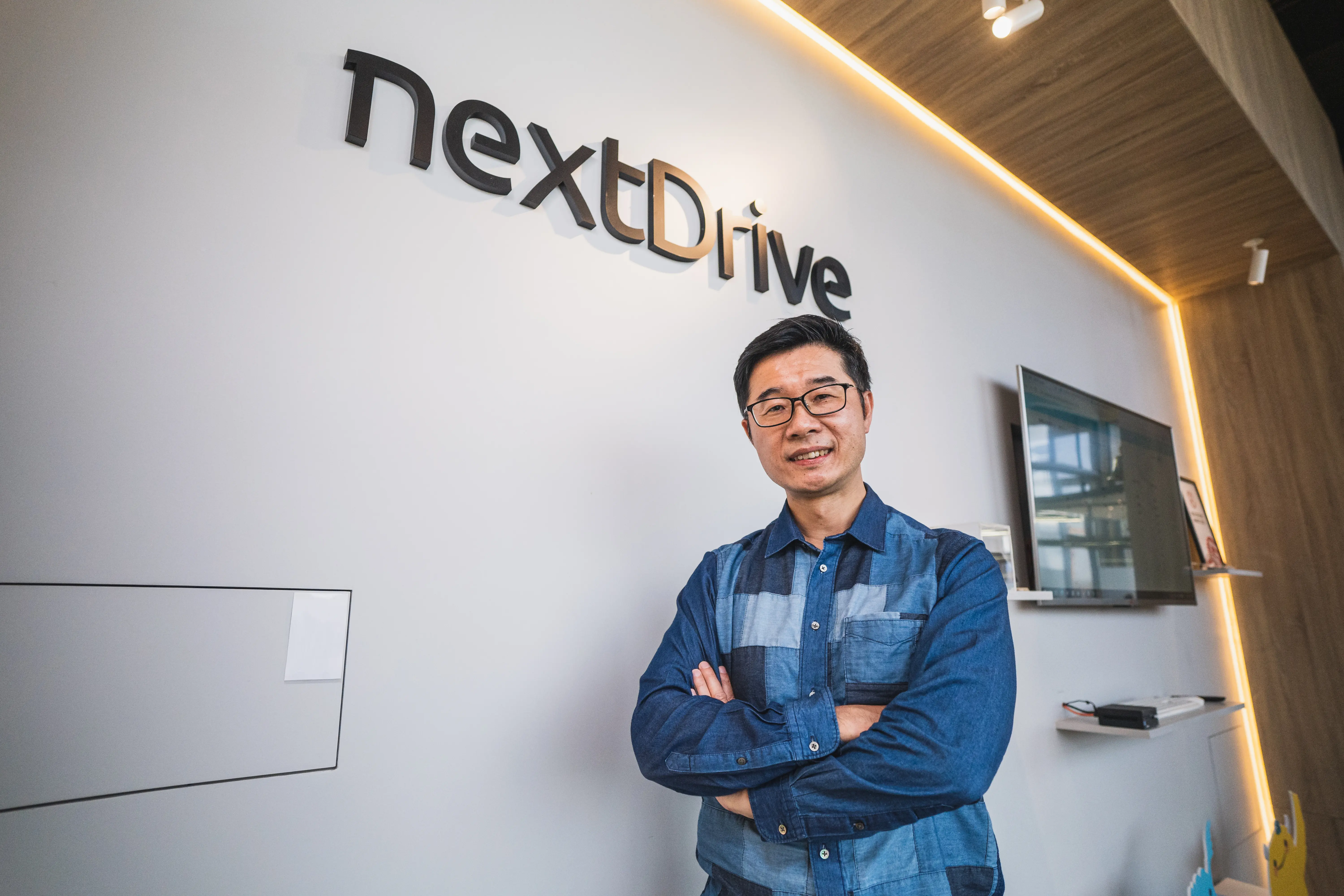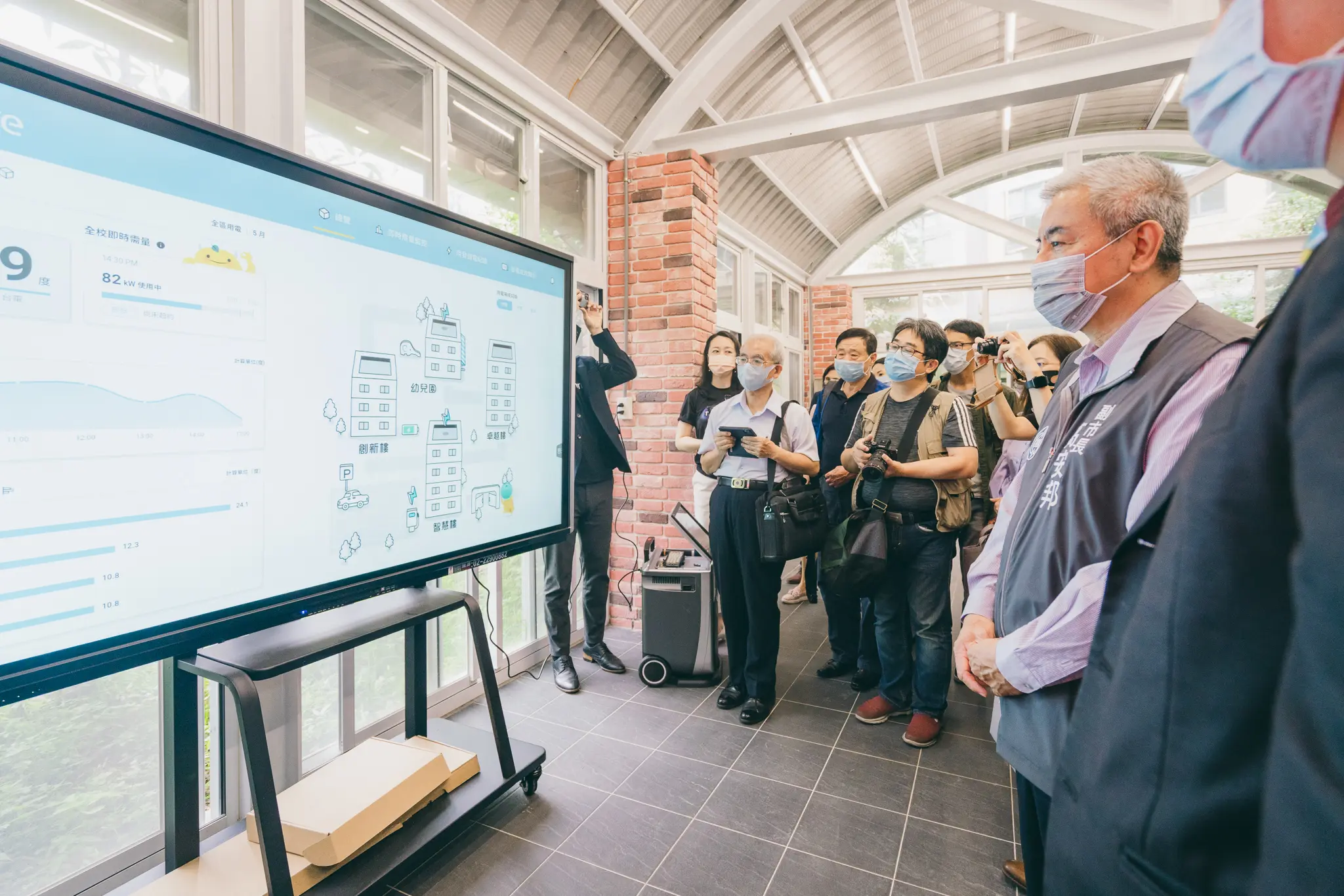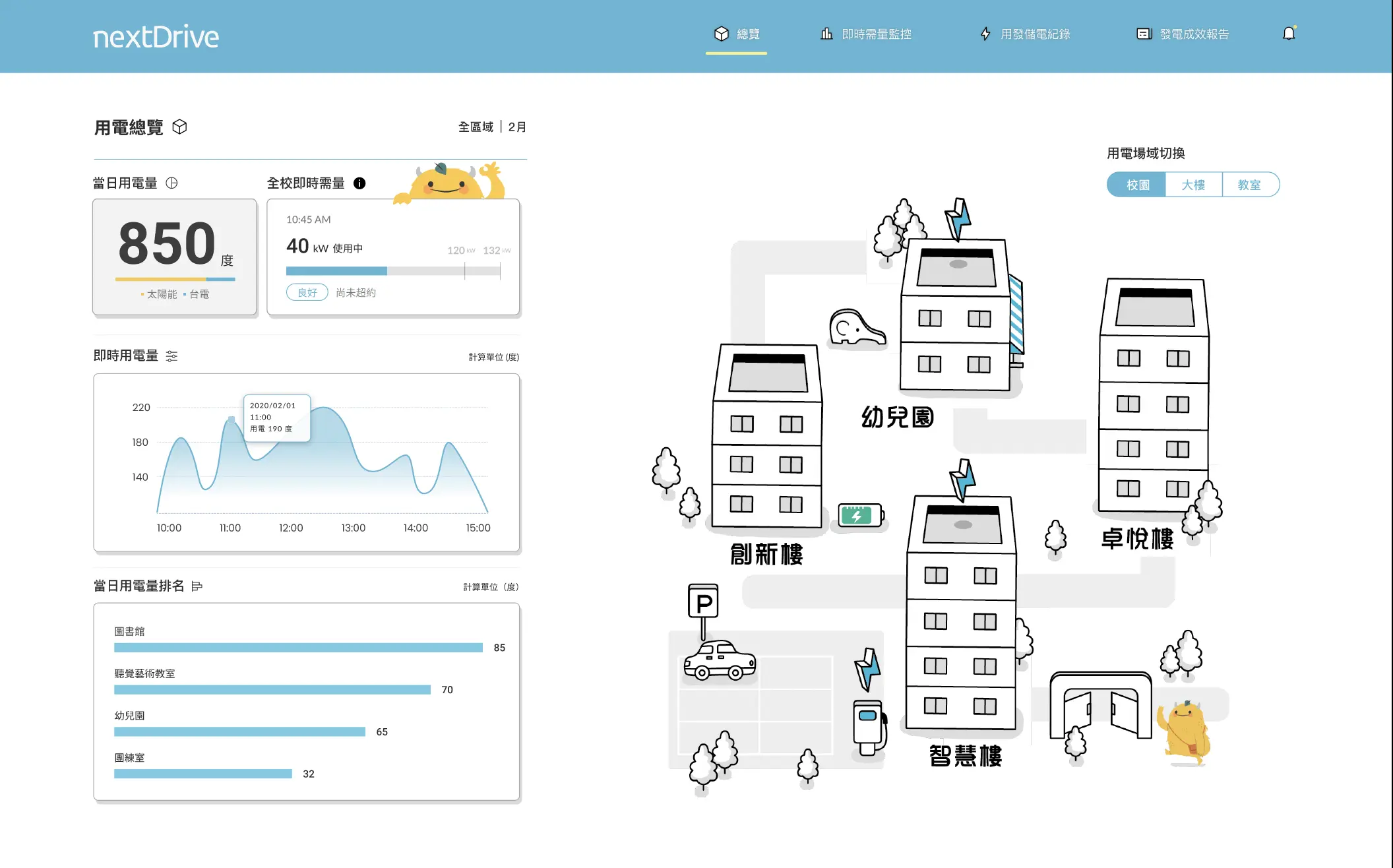The system is mainly aimed at expressing the concept of electricity utilization so that people can be aware of power consumption.
Integration of VR and Visualizing electricity consumption NextDrive incorporates VR technology as part of "smart management of electricity consumption"_Interview with Jeryuan Yen(Jerry Yen), founder and CEO of NextDrive Co.

Integration of VR and Visualizing electricity consumption NextDrive incorporates VR technology as part of "smart management of electricity consumption"_Interview with Jeryuan Yen(Jerry Yen), founder and CEO of NextDrive Co.

Jeryuan Yen(Jerry Yen), founder and CEO of NextDrive Co.
Interview by Xin-En Wu Written by Mei-Hsu Shih, Xin-En Wu
In early 2022, NextDrive Co ("NextDrive") and Taiwan Power Company ("TPC") announced the launching of "1% Energy Home", a new generation of Home Energy Management System (HEMS), which connect LINE APP with smart meters. With this app, people can check various electricity data through mobile phones, and set up power rate budgets as well as the reminders budget overrun.
"Our purpose to inform people about of electricity usage, raising awareness about electricity consumption," Yen said. Besides the advanced design, the APP embedded with it a sense of "social responsibility", allowing NextDrive to pioneer in the field of energy management.
Established in 2013, NextDrive has been focused on its core business, the management of platform of Internet of Energy, IoE, also known as the smart grid management. More than 80% of its sales are from Japan, with Japan's top five power giants, including such as Chubu Electric Power Company, Tohoku Electric Power Company, and others, as major clients. NextDrive, leveraging its extensive experience in energy management for tens of thousands of householders in Japan, is now ready to deploy its energy consumption solution in Taiwan, where energy transition is one of the top priorities for the island's export-oriented economy.
In March 2020, NextDrive successfully acquired Round B funding of US$10 million in total, from Arm IoT Fund, WI Harper Group, Alibaba Taiwan Entrepreneurs Fund, etc. In the end of 2021, NextDrive announced that it has successfully obtained the investment of Round C funding of US$ 31 million in total, from the Arm IoT Fund managed by ARM Holdings, Plc., and Sino-American Silicon Products Inc., Foxconn Technology Group, Ta Ya Electric Wire & Cable Co., Ltd., New Economy Ventures managed, etc.

Is it possible for us to shape an industry, in which we can formulate certain game rules in an industry and then consign the industry chain to carry out OEMs. At present, although such a pattern may be against the trends during recent years, a balance may be achieved finally, due to the current model of competition and cooperation heading toward regionalization and geopolitics. Taiwan is still capable of realizing any possibility.
A new mind set for OEM : from constructing a Virtual Power Plant to acting as a Resource Aggregator (RA)
In May 2021, Taoyuan City Wenxin Elementary School and NextDrive worked together to organize the first "virtual power plant at school" in Taiwan, introducing the "AI-based Regulatory Capacity" energy management system. Through the "IoT of Energy" technology, the electrical equipment at school is integrated as small VPP and the high-power electrical appliances at school are automatically regulated. Through these measures, the school can perform comprehensive observations on its energy usage situations, able to regulate the school's energy applications and loading equipment in advance, by predicting the demand at each interval throughout the day. This is a "virtual power plant at school" that combines the spontaneous self-use of green energy with AI-based regulatory power capacity.
Yen pointed out that virtual power plants can be applied to many occasions of electricity utilization, even at a household level. For example, in Japan, some household-type energy storage devices can be connected to power grids by means of proper management, allowing excessive power be fed into the grids for management. "Such a small household unit is an example of a small VPP power plant. As for larger scales, this can extend to the ones such as schools, commercial buildings and others. For even larger scales, this can be applied to the management of wind farms, power fields or regional power." The construction of virtual power plants is merely the first stage. Yen concentrates on a bigger picture. The second stage is aimed at assisting enterprises in participating in the auxiliary service market.

"Taiwan is a green field," said Yen. He believes every enterprise and every factory can serve as a virtual power plant. NextDrive can play the role of Resource Aggregator (RA), to assist enterprises in participating in the auxiliary service market. In other words, excessive electricity can be sold at better prices, so as to make money through these investments. "For business owners, these are not costs, but rather the tools for making profits, while meeting the needs of sustainable energy usage required by all walks of life."
In Yen's opinions, if nuclear power plants were destined to be phased out as part of government's 2050 nuke free plan, the supportive renewable energy and Smart Grid should be well prepared in advance. Citing Germany as an example, Germany had installed many onshore wind turbine generators (WTGs) which at its early stage questioned and protested by local residents. The German Government was quick to amend the laws and regulation to set a safe distance between onshore wind WTGs and residential areas. The German government foresees the intermittent nature of renewable energies, let it be solar or wind, so actions such as setting up resilient power grid have been taken to mitigate the impact. A perfect distributed smart gird to accommodate both traditional and renewable energies have yet been established. Yen believes this is a perfect opportunity for Taiwan to set up a demonstrative dispersed power grid leveraging the nations advantages. "Taiwan can do it, though Taiwan is a small island. To make things better, we must overturn the OEM thinking." according to Yen.
For the past several decades, Taiwan has been boasting its performance in OEM excellence. Therefore, when it comes to green energy development, the government replicates the model of OEM to green energy development, along with the requirement for the ratio of state-run energy businesses thereof. Yen observed the patter and thought it's similar to the way the government tried to cultivate a local automotive industry; foreign companies were introduced to Taiwan with the condition of technology localization. However, Taiwan never made it in cultivating the automotive industry, if in the perspective of division of labor among global industries.
"Is Taiwan suitable for making the output of OEM, the so-called "me-too"? Or are there other patterns easier for Taiwan to replicate? Naturally, this issue is somewhat linked to NextDrive because we intend to break off such traditions." Yen pointed out that Taiwan is quite good at making money, especially in a laborintensive way. "Take semiconductor industry as the example. We have run the operations to the fullest. Taiwan Semiconductor Manufacturing Company ("tsmc") has been indeed very powerful, sweeping 60% of the world's wafer OEM products, while developing utterly fine processes which are heavily subject to machine tools, thanks to large amounts of capital investments. In view of the tsmc's development over the past years, tsmc has surpassed United Microelectronics Corporation ("UMC"), because of its superior investments, especially in those cutting-edge machines bought from ASML Holding ("ASML"). Then, tsmc hires numerous engineers to improve the defect-free rate, so it outperforms others."
Yen continued to say. At that time, the semiconductor industry set its root in Taiwan, because it was an industry with high pollution and high energy consumption. Neither Americans nor Japanese had any interest in the industry. However, Taiwan has turned this industry into a shiny diamond. Even so, it has relatively great impact on environments and energy consumption. Therefore, Yen contemplated, "Is it possible for us to shape an industry, in which we can formulate certain game rules in an industry and then consign the industry chain to carry out OEMs. At present, although such a pattern may be against the trends during recent years, a balance may be achieved finally, due to the current mode of competition and cooperation heading toward regionalization and geopolitics. Taiwan is still capable of realizing any possibility."
In face of net zero emission challenges, Japan takes concurrent approaches
To achieve the goal of net zero emission in Taiwan, Yen believed that virtual power grids can be very helpful. He referred to Japan's experience as the reference for Taiwan. In his opinions, both Japan and Taiwan are islands, which heavily rely on imported energy. Compared to Taiwan, Japan has been facing even greater challenges. On the one hand, Japan has set up a goal for achieving 38% of the green energy by 2030.In 1997, Japan was one of the countries supporting the initiative of Kyoto Protocol at COP. Then, it also took part in Paris Accords. Now, it engaged in COP26 in Glasgow last year. Being the main advocator, Japan thinks itself as the one taking greater responsibility, and it should lead the trend.
As for how Japan will achieve its goal? Yen once discussed about this issue with the Vice President of Tokyo Electric Power Company ("TEPCO"). "The strategy Japan adopted was to win the competitive advantage by means of quantity. Roofs were exhaustively being set up with solar panels. Hence, approximately JPY 42 per kWh marked the very first Feed-in Tariff (FIT) rate in Japan, with the warranty of 10 years (vs. the warranty of 20 years in Taiwan). Though the FIT rate of JPY 42 was high, the government enabled those power suppliers to recoup their investments faster, while the electricity can be poured into the free market for making transactions. In terms of the possible outcome of "postFIT refugees", Japan government had taken preventative measures through legal amendments. That is, Feed-in Premium (FIP) will take effect, for the bidding on the wholesale of the electricity."
Another possible approach to take is to encourage RAs to come forward in recollecting the electricity, which can be the first step to a disperse power grids. Yen explained, in a sense, each house can serve as a virtual power plant with an independent virtual grid. He continued, "Renewable energy alone cannot fully achieve the goal of net zero emission. That was why the Japanese government has launched national subsidy programs, both at the levels of central and local governments. In Roppongi where NextDrive's office is located, even the district government has subsidized for household energy storages. Such storages were predominantly 6 kWh at the time when we installed them in place, which, amount to about 12 or 13 kWh now, as twice of the capacity as then. Our rooftop solar panels are not powerful enough during the day, and supplementary power from TEPCO is still required. Any excess electricity can be stored and used during the night." This is how the houses in Japan gradually became net zero emission houses (ZEH) and achieved the goal of 100% self-sufficiency in energy. Concurrently, Japan has also been constructing energy-saving buildings in the aspect of building laws and regulations, where energy consumption of a house can be reduced through alternative materials and ventilation designs.
Constantly facing natural conditions such as typhoons and earthquakes, by transforming the households in Japan to serve as a small virtual power plant for off-grid power dispatching, will help them to achieve self-sufficient on energy supply; hence, the purpose of disaster prevention can be achieved by means of these houses' self-powering. These disperse small virtual power plants served another function in national security. Yen explained, "Taking house and community as the unit in forming multiple disperse power grids of different scales, based on the size of the respective governmental administrative levels in Japan, namely prefectures, sub-prefectures, municipality, and sub-municipality, isolated smart power grids can be connected in each district".
Energy transition brings about new opportunities for Taiwan
"We all know Taiwan is an island, surrounded by oceans. If we see every community as an isolated island, than an advanced power dispatching system could sustain power supply during emergency. To put it straight forward, when a disaster occurs, the power plant at each community can provide sufficient energy and electricity for emergency use."

In theory, diversified power grids shall reach equilibrium to some extent in the long run, despite the diversity of the regulatory measures for the power grids. Yen said, however, it is easier to say than do, especially in Taiwan. "The reason? The extremely low electricity price" , which is why interventions through policies and statutes are necessary for regulating and steering the electricity market.
Yen added, Japan's practices encompassed sticks and carrots. On the one hand, the goals were gradually achieved through the requirements of policies and regulations; on the other hand, incentives and subsidies were provided simultaneously. Nevertheless, as laws and regulations continue to evolve, new business models continue to emerge. Where there are profits for businesses, enterprises are willing to get involved in the smart energy. And the more enterprises get involved, the more stabilized the entire power grid is getting.
"Taiwan is a heaven for capitalists. Taiwan offers extremely low costs of water and electricity. In addition, the relatively low salary also contributes to the making of the competitiveness of Taiwan. As it stands, only a handful of people might benefit from these low costs." According to the honest opinion from Yen, if Taiwan intends to experience a successful transformation in the power industry, costs therein shall be realistically reflected. Enterprises pocketing the profits need to be compelled to pay back to the society by acquiring smarter talents for the invention of new business models. "Only by doing so, the society can truly benefit, and the industry can truly progress. With suitable inflation under control, let the money flow more smoothly; isn't GDP created thereunder?" Therefore, Yen believed that the transformation of energy has provided Taiwan with a great opportunity, whilst positioning oneself in the right spot makes is crucial.
Yen believes that the most prominent advantage of Taiwan is it's the solid hardware supply chain. However, its competitiveness will eventually diminish with very little margin for re-investment. (i.e. like a "Maoshan Taoist priest" , with advanced kungfu yet a frugal lifestyle, to put in an ironical tone). Yen proposed that with value-added software, profit margins can be boosted by 30% to 40% to say the least. As it stands now, Taiwan might not be totally stand out among the competition with its "elements in the software basket" alone, yet with the combination of its software and hardware, Taiwan is definitely a strong contestant that cannot not be underestimated. In line with such thought, NextDrive is making the replication of the smart grid management model a reality, with the integration of virtuality and reality.
More related articles
